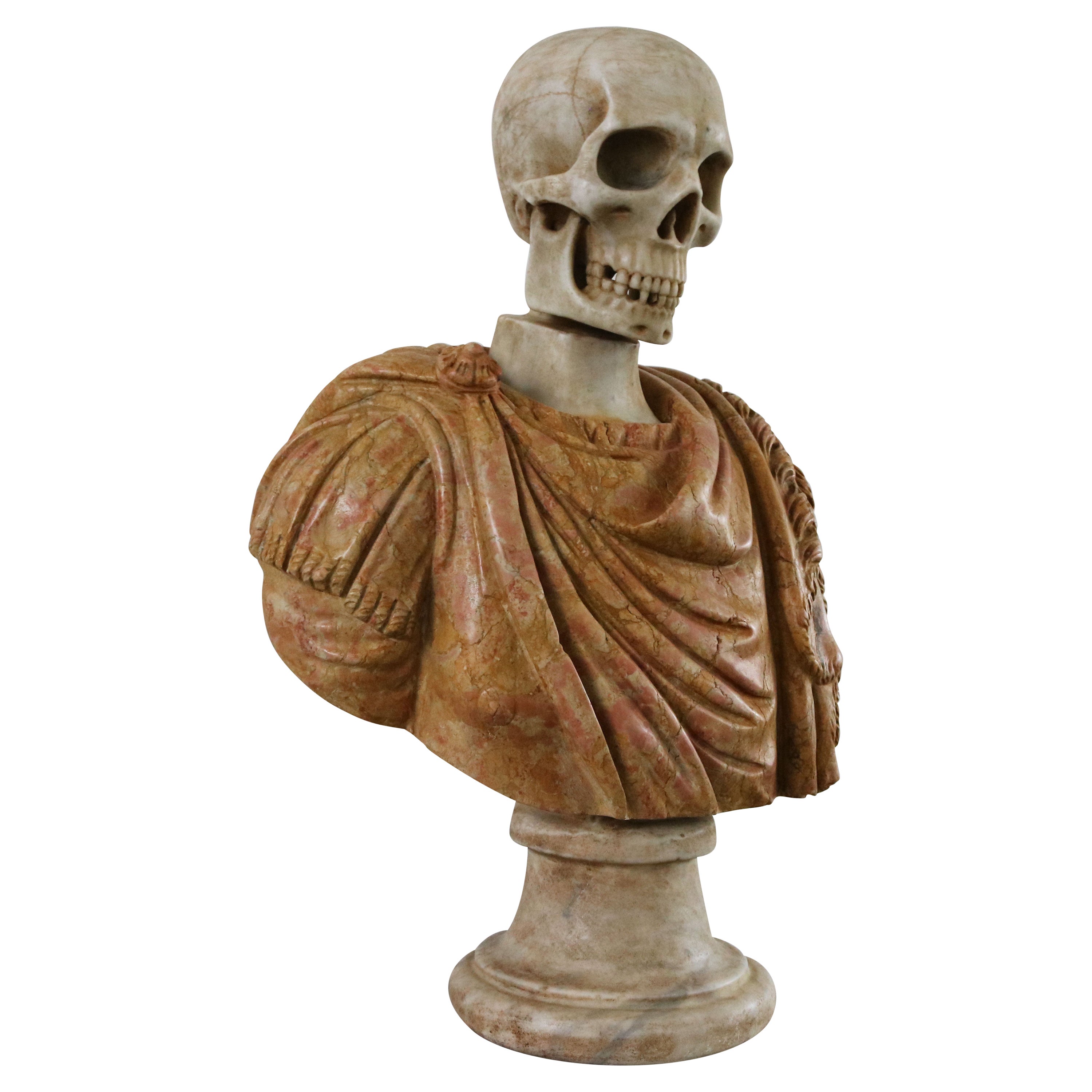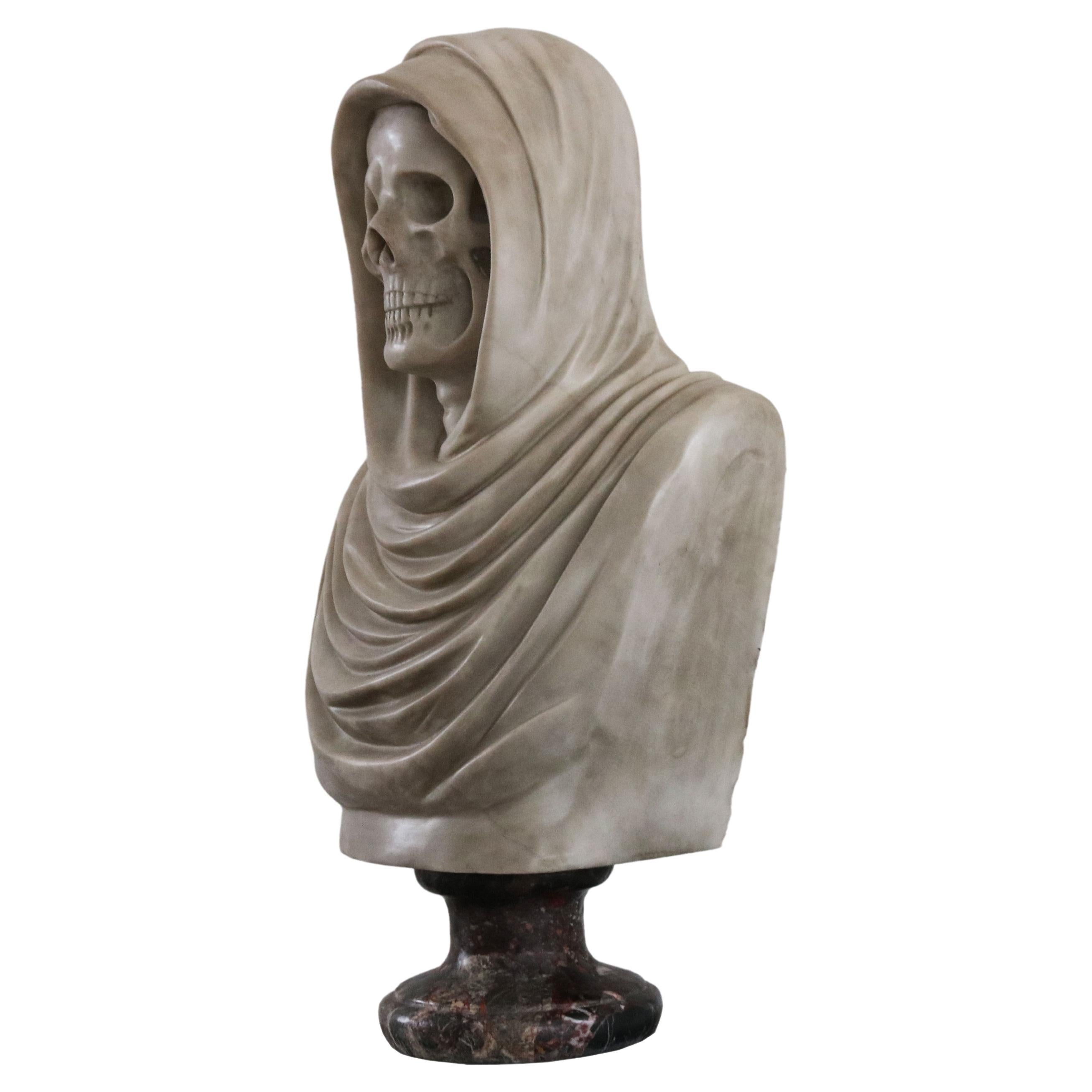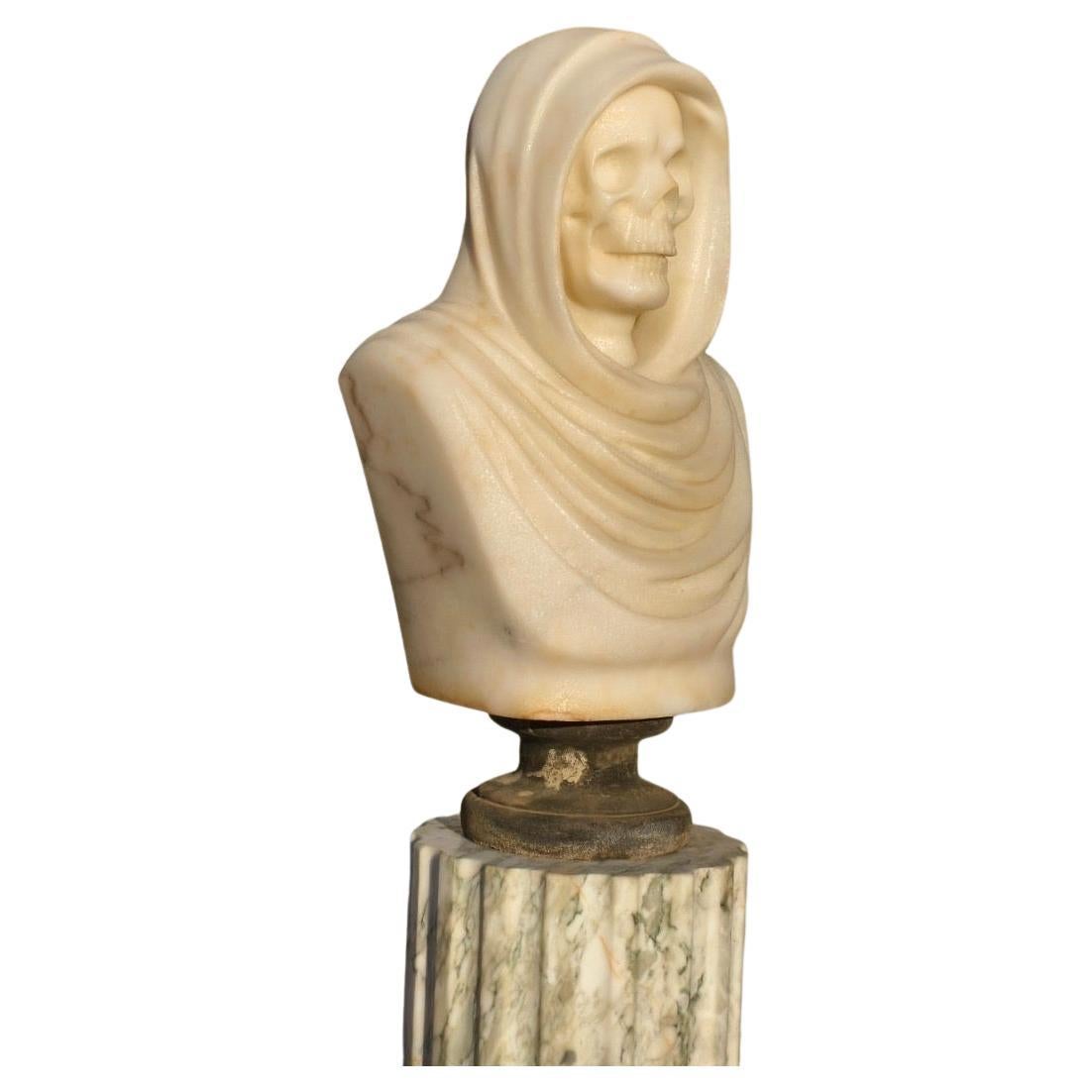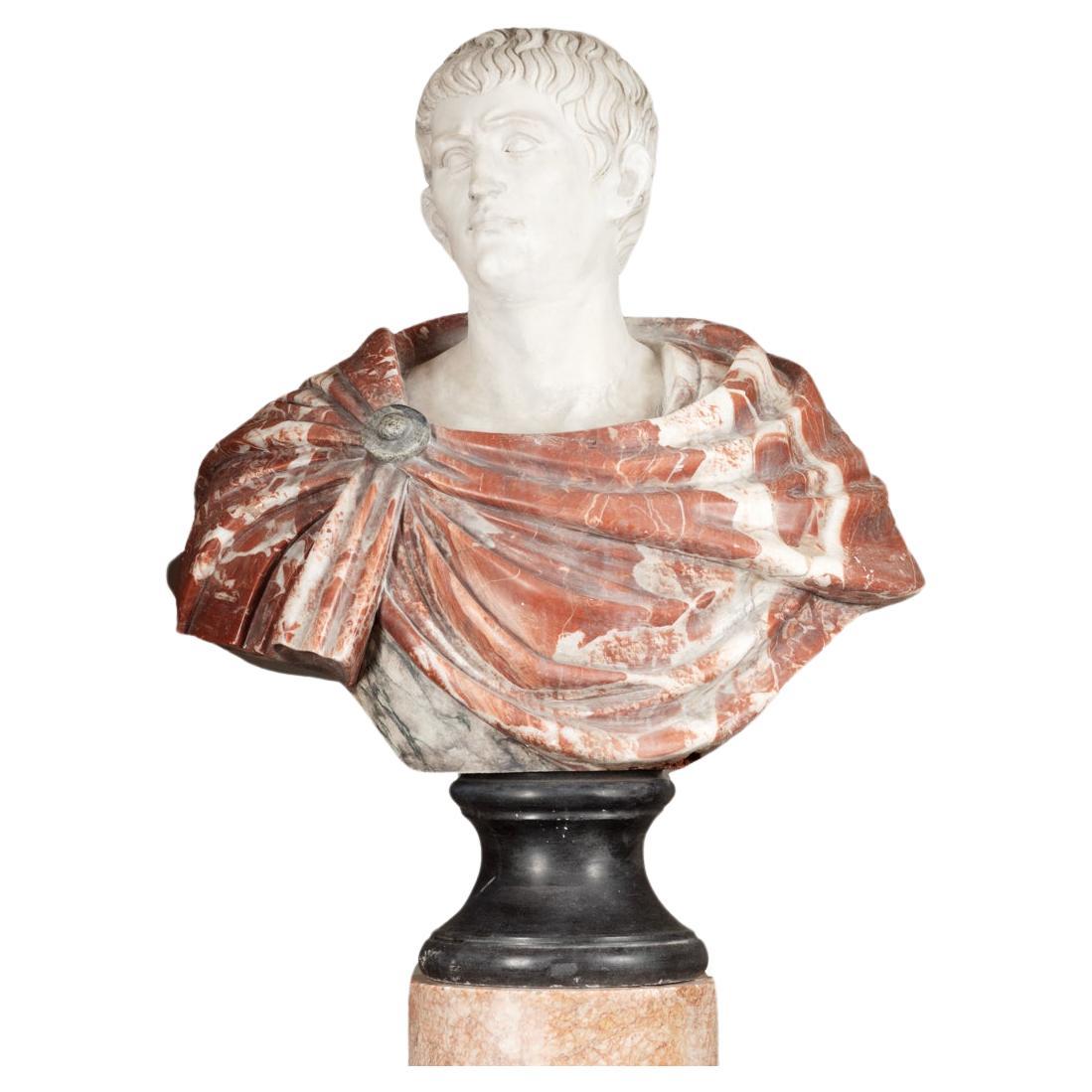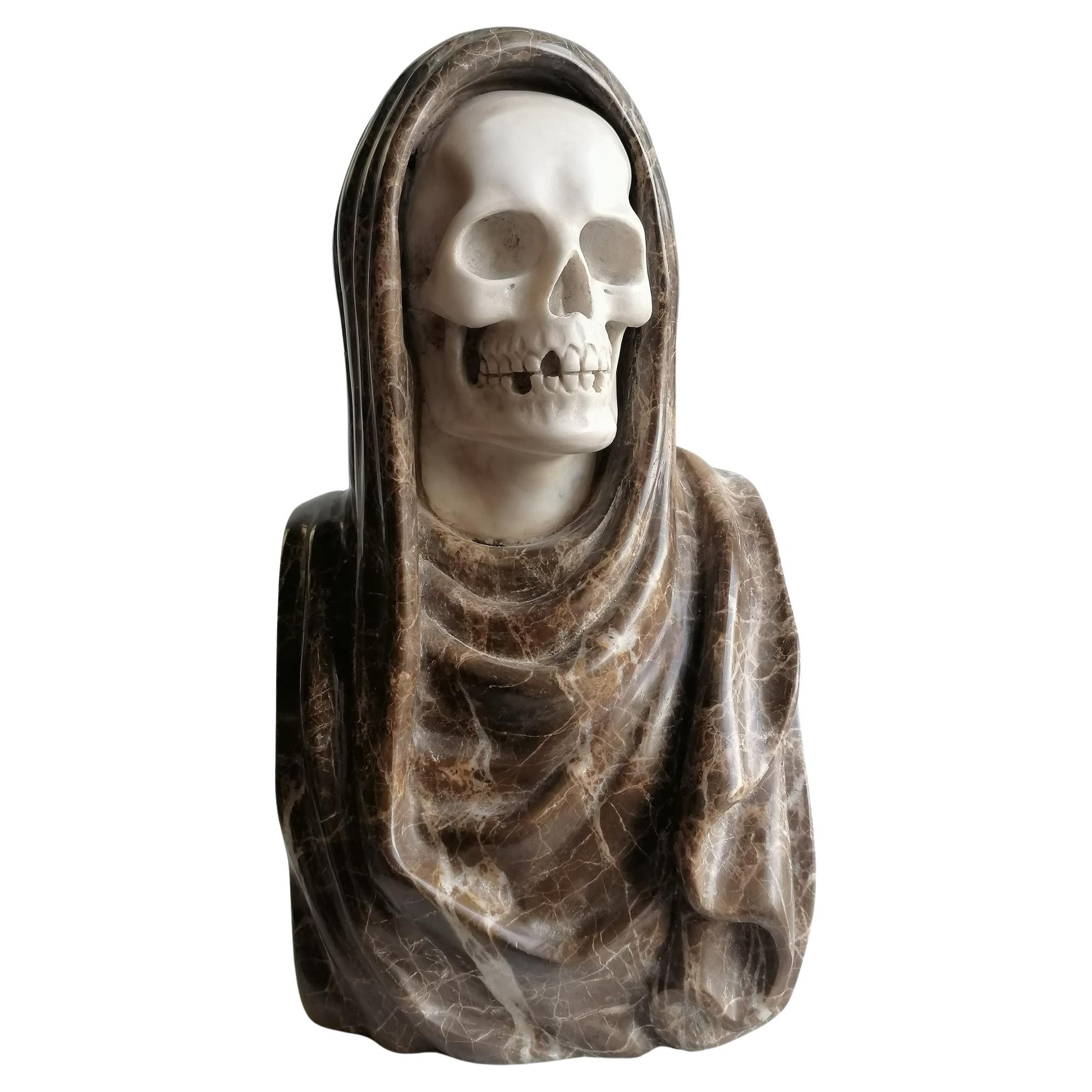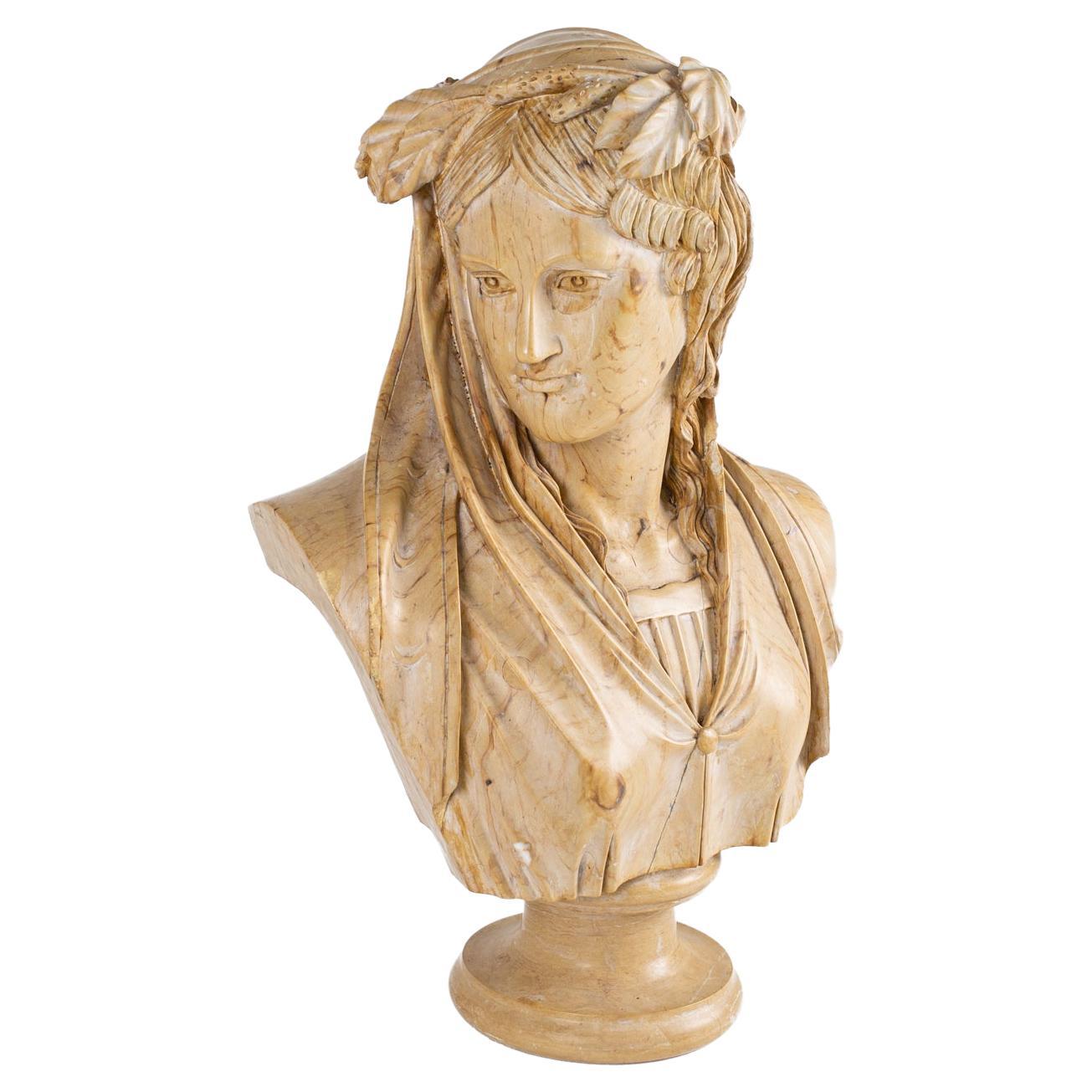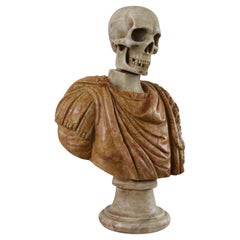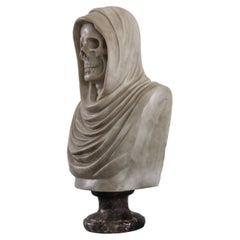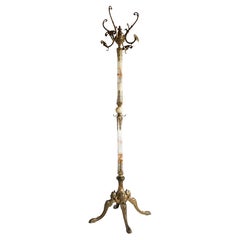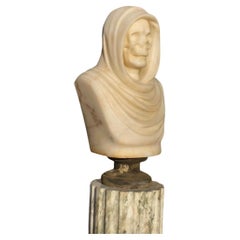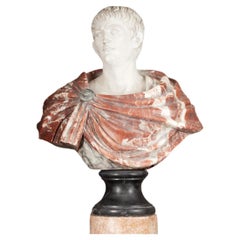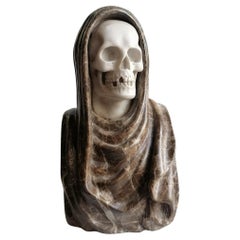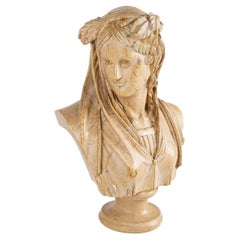Items Similar to 19th Century Italian Roman Vanitas Bust Renaissance Revival Memento Mori Marble
Video Loading
Want more images or videos?
Request additional images or videos from the seller
1 of 21
19th Century Italian Roman Vanitas Bust Renaissance Revival Memento Mori Marble
$16,422.76
£12,216.87
€13,695
CA$22,488.37
A$25,004.01
CHF 13,055.71
MX$304,359.64
NOK 166,585.20
SEK 156,082.37
DKK 104,252.47
Shipping
Retrieving quote...The 1stDibs Promise:
Authenticity Guarantee,
Money-Back Guarantee,
24-Hour Cancellation
About the Item
Masterfully carved & most impressive Italian Vanitas bust in solid marble from late 19th century.
White Carrara marble skull combined with a Belgian Black marble Roman toga (robe).
The roman toga shows gorgeous detail like curves / folds in the fabric , it looks stunning.
The skull is most impressive carved from Carrara marble and displaying a full laurel wreath crown around its head.
The laurel wreath crown is a roman display of triumph in battle which combines perfectly with the ancient roman custom this vanitas displays.
We have seen many marble sculptures during our lifetime but this one is simply breathtaking and a very large size.
The attention to detail and quality of the sculpture is superb, but this sculpture also carries a beautiful & strong message.
Memento mori is Latin for “Remember death.” The expression originates from a specific custom of ancient Rome; when a victorious general was back from war and was brought in triumphal procession through the streets, celebrated by the crowd, he could have been overwhelmed by pride and delusion of grandeur. To prevent this from happening, someone standing behind him, kept repeating: "Respice post te. Hominem te memento. " To remind him he is just a mortal man. The vanitas was also used in ancient Rome to remind you where you come from, you might have achieved great things but you should never forget your origin.
During Middle Ages Memento Mori was a medieval theory and practice of reflection on mortality, especially as a means of considering the vanity of earthly life and the transient nature of all earthly goods and pursuits with a hopeful approach to a glorious afterlife. During the Italian and European Renaissance the approach to the theme of vanitas changes, artists want to communicate to enjoy life with its earthly pleasures as everything is fleeting. The Vanitas movement had its maximum expression in Holland during 17th-18th centuries. The Thirty Years’ War (1618-1648) gave rise to a period of starvation and the art related to the Vanitas theme conveyed this sense of insecurity, later during 18th century Dutch artists used this theme in response to prosperity and attachment to world-pleasures and material goods. The concept of Vanitas can also be found in contemporary art among those artists who use their art for ethical purposes to denounce the way in which the human being is exploiting the world we are living and the way humans are depleting the resources of nature. In any case this concept brings a message of joy and hope. One interpretation could be linked to the hope of a life after death and the second in the urgency to enjoy the beauties that life offers us during our passage on earth.
This Vanitas sculpture refers to the old tradition of Ancient Rome and was hand carved in Italy during the renaissance revival late 19th century.
- Dimensions:Height: 29.53 in (75 cm)Width: 23.63 in (60 cm)Depth: 11.03 in (28 cm)
- Style:Renaissance Revival (Of the Period)
- Materials and Techniques:
- Place of Origin:
- Period:
- Date of Manufacture:1890
- Condition:Wear consistent with age and use.
- Seller Location:Ijzendijke, NL
- Reference Number:1stDibs: LU2997328063012
About the Seller
4.8
Vetted Professional Seller
Every seller passes strict standards for authenticity and reliability
Established in 2016
1stDibs seller since 2017
466 sales on 1stDibs
Typical response time: 7 hours
- ShippingRetrieving quote...Shipping from: Ijzendijke, Netherlands
- Return Policy
Authenticity Guarantee
In the unlikely event there’s an issue with an item’s authenticity, contact us within 1 year for a full refund. DetailsMoney-Back Guarantee
If your item is not as described, is damaged in transit, or does not arrive, contact us within 7 days for a full refund. Details24-Hour Cancellation
You have a 24-hour grace period in which to reconsider your purchase, with no questions asked.Vetted Professional Sellers
Our world-class sellers must adhere to strict standards for service and quality, maintaining the integrity of our listings.Price-Match Guarantee
If you find that a seller listed the same item for a lower price elsewhere, we’ll match it.Trusted Global Delivery
Our best-in-class carrier network provides specialized shipping options worldwide, including custom delivery.More From This Seller
View AllItalian Marble Bust Vanitas / Memento Mori 19th Century Carved Sculpture Italy
Located in Ijzendijke, NL
Masterfully carved Italian Vanitas bust in solid marble from late 19th century.
White Carrara marble skull combined with a red Rosso Imperiale marble Ro...
Category
Antique Late 19th Century Italian Renaissance Revival Busts
Materials
Marble, Carrara Marble
Rare 19th Century Italian Memento Mori Bust / Sculpture Carrara Marble Vanitas
Located in Ijzendijke, NL
Masterfully carved Italian Vanitas / Memento Mori bust in solid marble from late 19th century.
White Carrara marble skull combined with masterfully...
Category
Antique Late 19th Century Italian Renaissance Revival Busts
Materials
Carrara Marble
Antique 19th Century Spanish Wall Cabinet with Knight Dark Patina Classical
Located in Ijzendijke, NL
Exquisite 19th century Spanish colonial wall cabinet with a striking dark patina & carved knight.
Very nice small antique that brings the right charm & vibe to any room.
The interior has 4 compartments for storage.
The cabinets door is richly decorated with a Spanish knight...
Category
Antique Late 19th Century Spanish Spanish Colonial Shelves and Wall Cabi...
Materials
Wood
Italian Ornate Antique Brass & Onyx Square Marble Coat Hat Rack Hall Tree Stand
Located in Ijzendijke, NL
Italian ornate antique brass & onyx square marble coat hat rack hall tree stand Hollywood Regency Eye catcher Classic 60s
This high quality free ...
Category
Vintage 1960s Italian Hollywood Regency Coat Racks and Stands
Materials
Marble, Brass
Italian Ornate Antique Brass & Onyx Round Marble Coat Hat Rack Hall Tree 1950s
Located in Ijzendijke, NL
Italian Ornate Antique Brass & Onyx Round Marble Coat Hat Rack Hall Tree 1950s
This high quality free standing , ornate hall tree dates to the 1950...
Category
Vintage 1950s Italian Hollywood Regency Coat Racks and Stands
Materials
Marble, Brass
Neo Classical Alabaster Pendant / Chandelier Silver Bronze Renaissance Revival
Located in Ijzendijke, NL
Gorgeous Neoclassical alabaster chandelier / pendant. Fully hand carved alabaster shade with gorgeous colors and grain.
This chandelier comes straight from France and will leave a l...
Category
Antique 1880s French Neoclassical Revival Chandeliers and Pendants
Materials
Alabaster, Silver, Bronze
You May Also Like
Solid Marble Vanitas Bust Sculpture
Located in Southall, GB
A striking solid marble Vanitas bust sculpture, dating to the late 20th century, acquired from an esteemed antique dealer in Italy. This evocative piece captures the essence of class...
Category
Late 20th Century European Busts
Materials
Marble
18th Century Large Italian Marble Bust of Caesar Augustus
Located in Dublin 8, IE
18th Century Italian Marble Bust of Caesar Augustus. His draped robe is hand-carved in red rosso levanto marble with the face modelled in contrasting white Carrara marble. The piece ...
Category
Antique 18th Century Italian Neoclassical Busts
Materials
Marble, Carrara Marble
Memento or Vanitas carved on white Carrara and Emperador spain
By Laboratorio Todini
Located in Tarquinia, IT
memento marble, vanitas marble, vanitas bust, ancient Roman, Roman art, classical art, Greek art, bust, white Carrara marble, emperador bust, classical sculpture, ancient sculpture, ...
Category
Early 2000s Italian Baroque Busts
Materials
Carrara Marble
Roman Style Solid Marble Bust
Located in Countryside, IL
Roman style solid marble bust
This bust measures: 15 wide x 10 deep x 23 inches high
This piece is in Great Vintage Condition with minor marks,...
Category
20th Century American Classical Roman Busts
Materials
Marble
Italian 19th Century Neo-Classical St. Marble & Ormolu Bust
By Luigi Betti
Located in West Palm Beach, FL
A sensational and stately Italian 19th century Neo-Classical st. white Carrara marble and Ormolu bust signed, Betti and stamped Pinedo. The striking bust depicts Roman Emperor Julius...
Category
Antique 19th Century Italian Neoclassical Figurative Sculptures
Materials
Marble, Ormolu
17th Century Italian Carrara Marble Bust of Classical Roman
Located in Houston, TX
17th century Italian carrara marble bust of a Classical Roman.
Finely carved Classical Roman Carrara marble bust sculpture from the 17th ce...
Category
Antique 17th Century Italian Classical Roman Busts
Materials
Marble
More Ways To Browse
19th Century Italian Renaissance Furniture
Large Italian Marble Sculpture
Large Roman Sculpture
Ancient Roman Marble
Italian Renaissance Revival
Italian Renaissance Marble
Life Size Marble Sculpture
18th Century Marble Sculpture
Roman Head Sculpture
Italian Hand Carved White Marble Sculpture
Dutch Renaissance Furniture
Roman Marble Head
Memento Mori Skull
Large Head Bust
Marble Antique Roman Marble Heads
Medieval Marble
Black Roman Bust
18th Century Marble Bust
